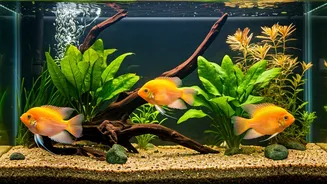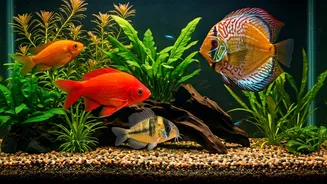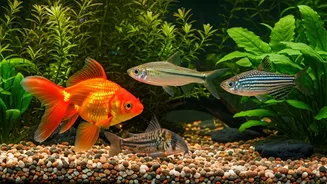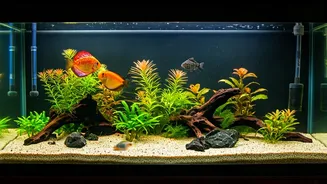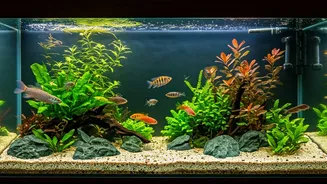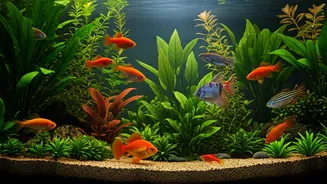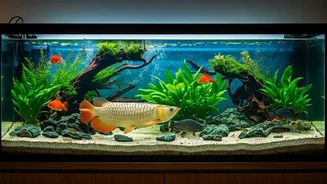Introduction: Aquatic Companions
Aquarium keeping can be an immensely rewarding hobby. Selecting fish species that can offer longevity allows aquarists to form lasting bonds with these
underwater creatures. Many fish have shorter lifespans, while others, with the proper care and conditions, can grace your aquariums for a decade or even longer. This guide highlights five such species, providing essential information to help ensure they live long, healthy lives. The following sections will detail each fish, discussing their care needs, ideal tank conditions, and how to create a thriving environment where they can flourish for many years to come. Considerations such as water quality, tank size, and social compatibility will be explored to provide a comprehensive understanding of each fish's requirements.
Pygmy Corydoras: Miniature Marvels
Pygmy Corydoras, small but charming, are ideal for smaller aquariums. These fish, typically reaching only about an inch in length, are peaceful and suitable for community tanks. They prefer a planted environment with plenty of hiding places and a sandy substrate, which is essential to protect their sensitive barbels. These bottom-dwelling fish require clean, well-oxygenated water, so regular water changes and efficient filtration are important. With proper care, these tiny Corydoras can live for up to five years or even longer. The Pygmy Corydoras are happiest in groups, so it is recommended to keep them in schools of six or more to promote their natural behaviors and reduce stress.
Plecostomus: Algae-Eating Giants
Plecostomus, commonly referred to as Plecos, are popular for their algae-eating habits. These fish can grow quite large, so they need substantial tank space. An aquarium of at least 75 gallons is recommended for most Pleco species. They thrive in tanks with driftwood and rocks to provide hiding spots, and a varied diet that includes algae wafers, vegetables, and occasional protein-rich foods is crucial for their well-being. Proper filtration is also essential to manage the waste these fish produce. Depending on the species, Plecos can live for over 10 years, making them a long-term commitment. Always research the specific Pleco species, as their needs may vary, but all Plecos benefit from clean water and ample space.
Betta Fish: The Siamese Fighter
Betta fish, also known as Siamese fighting fish, are striking in appearance and can be kept in smaller tanks. Male Bettas, known for their vibrant colors and flowing fins, are best kept alone to avoid fighting. Bettas require a heated tank with a temperature between 75°F and 82°F (24°C and 28°C), and a well-filtered environment. They are labyrinth fish, which means they can breathe from the surface, but a gentle water flow is still important. Regular water changes and a balanced diet of high-quality betta pellets or flakes, supplemented with occasional treats like bloodworms, will keep your Betta happy and healthy. With the right care, these beautiful fish can live for 3-5 years, sometimes even longer.
Angelfish: Graceful Swimmers
Angelfish, known for their elegant, disc-shaped bodies, add a touch of grace to any aquarium. These fish need a tall tank, as they grow vertically, with a minimum size of 55 gallons recommended. They prefer a planted tank with ample swimming space and should be kept with other peaceful community fish. Angelfish thrive in a warm, well-maintained aquarium with regular water changes. Their diet should include a variety of flake food, pellets, and occasional live or frozen foods. Angelfish can live for 10 years or more with optimal care, providing years of visual enjoyment. Note that Angelfish are territorial, and may eat smaller fish. Proper research regarding their compatibility is essential before introducing them into a community tank.
Goldfish: Classic Companions
Goldfish, a classic choice for many aquarists, can also live for a surprisingly long time. These fish thrive in cooler water than tropical species, and they need plenty of space. Fancy goldfish varieties often require larger tanks (at least 20 gallons per fish) due to their body shape and swimming habits. A well-filtered tank with regular water changes is essential. Goldfish also need a varied diet, including goldfish flakes, vegetables, and occasional treats. Overfeeding and poor water quality are major contributors to their health issues, so it is important to monitor and maintain their environment carefully. With proper care, Goldfish can live for over 10 years and some even longer, making them a long-term commitment. Ensure you have the space and resources to care for them properly.
